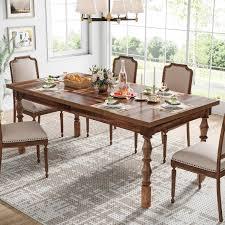Sponsorluk
How the Type of Wood Affects Dining Table Pricing

How the Type of Wood Affects Dining Table Pricing
Dining tables are not only functional centerpieces in a home—they also reflect the style, character, and budget of their owners. One of the biggest factors influencing the cost of dining tables is the type of wood used in its construction. From the density and durability to rarity and sourcing, wood selection plays a vital role in shaping a table’s price tag. Whether you’re shopping for a rustic farmhouse table or a modern sculptural piece, understanding how different woods affect dining table pricing can help you make smarter, longer-lasting choices.
Hardwood vs. Softwood: A Foundational Difference
The first distinction to understand is between hardwoods and softwoods. Despite the names, the classification isn’t strictly about the hardness of the wood, but rather the tree species it comes from.
-
Hardwoods come from deciduous trees (those that lose their leaves) and tend to be denser, more durable, and often more expensive. Common examples include oak, walnut, maple, cherry, and mahogany.
-
Softwoods come from coniferous trees (evergreens) and generally grow faster, making them more available and typically more affordable. Pine, fir, and cedar fall into this category.
Because of their strength and beauty, hardwoods are more ***rable for long-lasting, high-quality dining tables—but they come at a higher cost. Softwoods, while budget-friendly, may dent or scratch more easily and aren’t as long-lasting under heavy daily use.
Price Ranges by Wood Type
Let’s break down popular woods and how they influence pricing:
1. Oak
Oak is one of the most common hardwoods used for dining tables in the United States. Known for its strong grain patterns and impressive durability, oak offers great value. White oak, in particular, is moisture-resistant and suited for both modern and traditional styles.
-
Price Range: $800 – $3,500+
-
Pros: Durable, classic, widely available
-
Cons: Can be heavy, may yellow with age
2. Walnut
Walnut is a premium hardwood prized for its rich brown tones and intricate grain. It’s often used in luxury and heirloom-quality tables. Walnut’s slow growth and lower availability push it into the higher price tier.
-
Price Range: $1,200 – $6,000+
-
Pros: Elegant, long-lasting, ages well
-
Cons: Expensive, scratches more easily than oak
3. Maple
Maple is a hard, fine-grained wood that resists scratching and wear. It has a light, clean look perfect for modern homes and Scandinavian ***gns.
-
Price Range: $700 – $2,500+
-
Pros: Strong, consistent grain, mid-range cost
-
Cons: Can be tricky to stain evenly
4. Cherry
Cherry wood darkens and deepens over time, taking on a rich, reddish tone. It’s softer than maple or oak, but valued for its beautiful, maturing appearance.
-
Price Range: $900 – $3,000+
-
Pros: Warm tone, fine grain, elegant aging
-
Cons: Softer, can dent or scratch more easily
5. Pine
A common softwood, pine is affordable and easy to work with, making it popular for budget-conscious or rustic-style tables. However, it dents easily and is less resilient to wear.
-
Price Range: $300 – $1,000+
-
Pros: Budget-friendly, lightweight
-
Cons: Less durable, prone to scratches and dents
6. Mahogany
Often associated with antique and luxury furniture, mahogany is known for its reddish-brown tone, smooth texture, and resistance to rot. It’s a traditional favorite for formal dining rooms.
-
Price Range: $1,500 – $6,000+
-
Pros: Rich color, prestigious, rot-resistant
-
Cons: High cost, less available sustainably
7. Teak
Teak is a tropical hardwood that’s highly resistant to water and pests. It’s used in both indoor and outdoor furniture and gains a silvery patina over time.
-
Price Range: $1,000 – $4,000+
-
Pros: Durable, water-resistant
-
Cons: Expensive, may be overharvested if not certified
How Finish and Thickness Affect Price
Beyond the wood species, the way the wood is finished and the thickness of the tabletop also affect the final price. Hand-applied finishes, such as oil rubs or artisan stains, add labor cost. Thicker slabs (especially live edge or butcher-block styles) use more material and thus cost more. In contrast, veneered or engineered wood tables (like MDF with a wood finish) are more affordable but lack the authenticity and longevity of solid wood.
Sustainability & Sourcing: The New Premium
Modern consumers increasingly value sustainably sourced woods. Certified woods (like FSC-certified oak or maple) usually cost more due to ethical harvesting and reduced environmental impact. Exotic woods like rosewood or zebrawood—though visually stunning—may carry both a high price and ethical concerns if not properly certified.
Imported vs. Domestic Wood Tables
Imported hardwood tables—especially those made in Europe—often come with premium price tags due to craftsmanship, shipping, and currency exchange. Domestic tables, especially those made in the U.S. using locally sourced woods like walnut or maple, may offer better value while supporting local artisans and sustainability.
FAQs
Q1: Is hardwood always better than softwood for dining tables?
A: Generally, yes. Hardwoods offer greater durability, strength, and resistance to daily wear. However, high-quality softwood like knotty pine can be a beautiful, affordable alternative if you’re okay with more maintenance.
Q2: Does engineered wood look the same as solid wood?
A: Not quite. Engineered wood (like MDF or particle board with veneer) can mimic solid wood visually but lacks the grain depth and longevity. It's lighter and cheaper but doesn’t hold up as well over time.
Q3: Why do two oak tables have very different prices?
A: Variations in craftsmanship, ***gn, brand reputation, finish quality, and wood sourcing all play a role. One might be handcrafted in the U.S. with thick cuts of white oak, while the other could be mass-produced with thinner slabs and machine finishes.
Q4: Which wood offers the best balance of quality and price?
A: Oak and maple are two of the best value woods—affordable, durable, and stylish for both traditional and modern dining spaces.
Q5: Can reclaimed wood tables be more expensive than new wood tables?
A: Yes, because they require more labor to clean, cut, and finish properly. Their aged appearance and eco-friendliness also boost their appeal and price.
Conclusion
Wood type plays a huge role in dining table pricing—from soft, affordable pine to rare, luxurious walnut. While hardwoods typically demand higher prices due to their durability and natural beauty, softwoods can offer charm at a fraction of the cost. It all comes down to your budget, usage, and ***gn preferences. By understanding how different wood types influence price, you can shop more confidently and find a table that truly fits your needs.
My Signature Home Furniture is one of the best places for the lowest Dining Tables prices in United States, offering a curated selection of beautifully crafted tables in oak, walnut, pine, and more—***gned to fit every home and budget.






